Water chestnut is a type of aquatic plant with edible fruits. It is an excellent source of dietary fiber and potassium, which can improve the digestion and regulate blood pressure. In addition, it has been reported that water chestnut is a good source of antioxidants.
Water Chestnut is a superfood with benefits! In this article, we will cover the different benefits of water chestnut, some nutrition facts, side effects and recipes you can make at home.Water chestnut is a type of aquatic tuberous fruit/vegetable that grows muddy and marshy underwater.
The fruit has various names including water nut, ling nut, mustache nut, ling Kio nut, devil pod, and singhara.
The fruit is native to Southeast Asia, East Asia, China, India, and islands in the Pacific & Indian Oceans.
There are three types of water chestnut: Indian water chestnut, Chinese water chestnut & European water chestnut.
Though the fruit/vegetable is called water chestnut, it is not a nut. It’s rather shaped like a chestnut.

Table of Contents
Water Chestnut Nutrition
As per USDA, 4 raw (36g) water chestnut has the following nutritional values:
- Calories – 35
- Sodium – 5 mg
- Fat – 0g
- Carbohydrates – 8.6 g
- Sugar – 1.7 g
- Fiber – 1.1 g
- Protein – 0.5 g
Water nut also has the following vitamins, minerals & antioxidants:
- Vitamin B6
- Vitamin C
- Potassium
- Copper
- Magnesium
- Riboflavin
- Iron
- Calcium
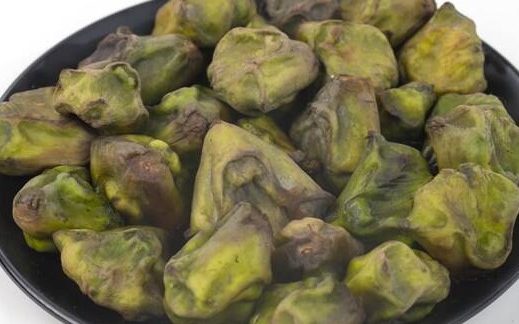
Health Benefits
Water nut has various antioxidant compounds and has many health benefits. Some of the health benefits of listed below:
High in Antioxidants that Fight Disease
Antioxidants are abundant in water chestnuts. In the body, free radicals, or potentially harmful molecules, are prevented by molecules called antioxidants.
In the body, free radicals can cause harm, so antioxidants help to protect the body against them. Chronic diseases, such as diabetes, heart disease, and many types of cancer, have been linked to oxidative stress.
Water nuts contain antioxidants that are capable of effectively neutralising the free radicals, which are responsible for causing chronic diseases.
Reduces Risk of High Blood Pressure & Heart Disease
Across the globe, heart disease is the number one cause of death. Strokes, high blood triglycerides, and high blood pressure all increase the risk of heart disease.
Traditional uses of water chestnuts include treating risk factors such as hypertension.
A water chestnut is an excellent source of potassium. Those who consume potassium-rich diets have lowered their risk of high blood pressure, heart disease, and stroke.
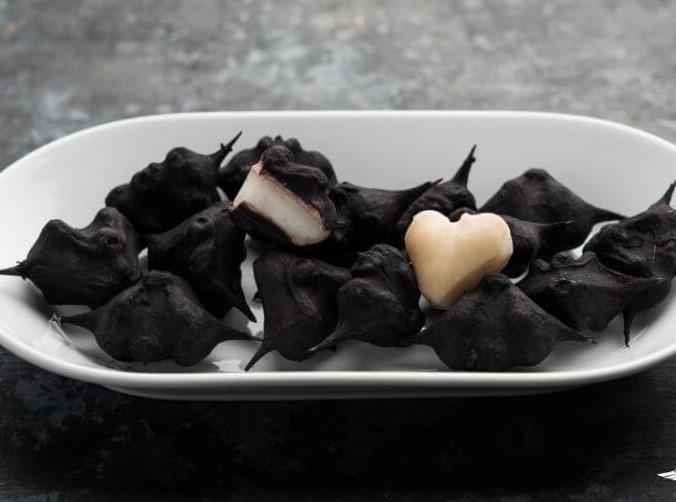
Helps in Weight Loss Diet
Water Chestnut is a high-volume food composed of 74% water. Water and air are both components of high-volume foods. The two are calorie-free.
Although high-volume foods have low calories, they can curb hunger quite effectively.
Losing weight can be made easier by substituting less filling foods for foods like water chestnuts that are equally filling but provide similar calorie amounts.
Reduced Risk of Cancer
Water chestnuts retain their crunchiness after they have been cooked due to this antioxidant.
There is a high chance that water chestnuts’ anticancer effects are linked to their antioxidant content.
The growth and spread of cancer cells depend heavily on free radicals. Cancer cells may grow more slowly as antioxidants in water nuts neutralise free radicals.
Promotes Bowel Movements
As a good source of fiber, water chestnuts provide 12,000 mg of fiber per day for women and 16,000 mg for men. A study shows that fiber consumption may aid in smooth bowel movements, blood cholesterol reduction, blood sugar regulation, and gut health.
Side Effects
Water chestnuts also have several side effects despite their impressive list of benefits. The Food and Drug Administration has revealed that consuming excessive amounts of water chestnuts can result in nausea, abdominal pain, or vomiting. Also, water nuts can trigger phlegm when consumed by someone who has a cold.
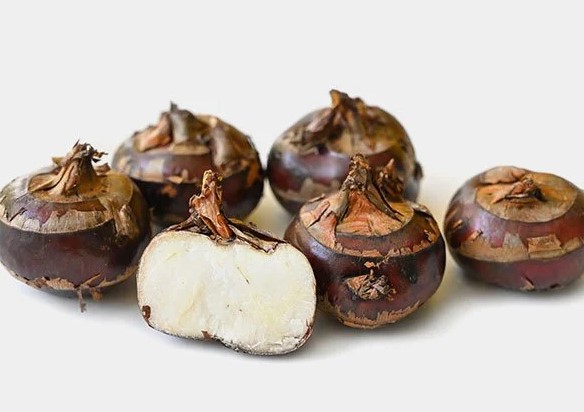
How To Eat Water Chestnut
Asian countries are known for their delicacy of water chestnuts. Asian countries are known for their delicacy of water chestnuts.
As a result of their versatility, they can be consumed raw, grilled, boiled, fried, pickled, or sweetened.
- It is common to add water chestnuts to stir-fries, omelettes, chop suey, curries, and salads, among other dishes, by peeling, dicing, slicing or grating them.
- After washing and peeling, they also make a delicious snack, as their flesh is sweet and crisp like an apple. It is interesting that the flesh remains crisp even after frying or boiling.
- Dry and ground water chestnuts can be used in place of flour by some people. In Asian markets, you can buy fresh or canned water chestnuts.
Recipes
Water Chestnut is a versatile fruit/vegetable and can be used in many different recipes. We have listed below some delicious water chestnut recipes:
Chinese Style Water Chestnut Stir fry

Ingredients:-
- Water chestnut – 300 grams
- Red bell pepper, cubed
- Yellow bell Pepper, cubed
- Broccoli, chopped small
- Mushrooms, quartered
- Bok Choy, diagonally cut
- Spring Onion, finely chopped
- 2 tablespoon Soy sauce
- Black pepper powder
- Salt
- Oil
Recipe:-
Step 1 – Pressure Cook water chestnuts for about 8 whistles or boil them fully.
Step 2 – After it gets cooled, peel off the black skin. Then rinse them & chop into halves.
Step 3 – Now, heat a wok with oil, add chopped yellow or red bell peppers, broccoli, mushroom, & other vegetables and stir fry till they are soft and crunchy.
Step 4 – Next add water chestnut and fry for 5 mins. Lastly add soy sauce, salt, & pepper and toss for a few more minutes.
Step 5 – Garnish with spring onions (optional).
Chicken with Water Chestnut
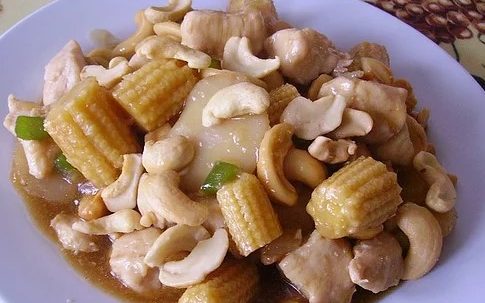
Ingredients:-
- Cornstarch – 2 tablespoons
- soy sauce – 3 tablespoons
- chicken broth – ⅔ cup
- ground ginger – ½ teaspoon
- hot pepper sauce – ½ teaspoon
- Chicken breast boneless & skinless, cut into strips – 1 pound
- Sliced & drained water chestnuts – 1 can (8 ounce)
- Onion, chopped – 1 small
- Cashews – ⅔ cup
- Green or yellow bell pepper, chopped
- Vegetable oil – 2 tablespoons
Recipe:-
Step 1 – In a large bowl, combine the chicken broth, cornstarch, soy sauce, ginger, & hot sauce, and set aside.
Step 2 – In a large skillet or wok, heat half of the oil until hot.
Step 3 – About five minutes later, add the chicken back in and continue stirring the dish till the chicken’s pink color disappears.
Step 4 – Set the chicken aside after removing it from the wok.
Step 5 – Add the onion, green or yellow bell pepper, and water chestnuts to the wok with the remaining tablespoon of oil.
Step 6 – For another five minutes, cook and stir the chestnuts and onion until they are hot & soft.
Step 7 – Add the sauce to the wok, toss to distribute the cornstarch, and cook until the sauce boils.
Step 8 – As the sauce thickens, stir in the chicken until it is hot.
Step 9 – Garnish with split cashews (optional).
Bacon Wrapped Water Chestnut
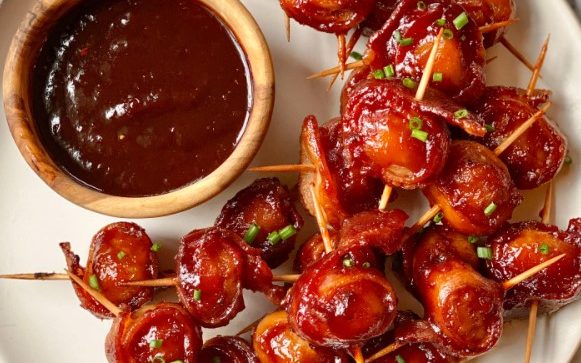
Ingredients:-
- Sliced Bacon – 1 pound
- Ketchup – 1 cup
- Water Chestnut (Whole) – 1 can, rinsed & drained
- Brown Sugar – ¾ cup
Recipe:-
Step 1 – Slice bacon into thirds.
Step 2 – Each water chestnut should be wrapped in a divided strip and secured with a wooden toothpick.
Step 3 – Put in an ungreased 15×10 inch baking pan.
Step 4 – Put in the oven and bake at 375 degrees for 25 minutes until the bacon is crisp.
Step 5 – In a small saucepan, combine brown sugar and ketchup. Heat over medium heat, stirring constantly until sugar is dissolved.
Step 6 – Now, drain the chestnuts on paper towels.
Step 7 – Put the ketchup mixture in a lightly oiled 13×9 inch baking dish and dip the water chestnuts in ketchup.
Step 8 – Spread the remaining sauce over the chestnuts.
Step 9 – Cook for an additional 10 minutes.
Conclusion
In conclusion, the fruits of water chestnut are an excellent source of potassium, zinc and calcium as well as some vitamins like C and B6. They contain the highest amount of protein than any other fruit.
It is known to help in weight loss and prevent obesity. Water chestnut is also considered a natural anti-inflammatory agent and is a good source of fiber.
Though the fruit has so many benefits, we recommend our readers to consume water chestnuts with caution because having too much can cause negative side effects.
